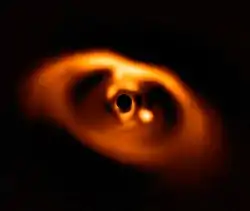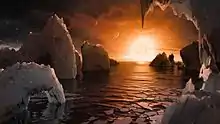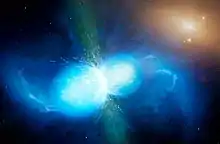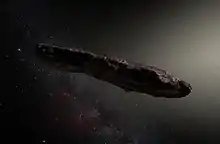TRAPPIST-1e
TRAPPIST-1e, also designated as 2MASS J23062928-0502285 e, is a solid, close-to-Earth-sized exoplanet orbiting within the habitable zone around the ultra-cool dwarf star TRAPPIST-1 approximately 40 light-years (12 parsecs), or nearly 3.7336×1014 km) away from Earth in the constellation of Aquarius. The exoplanet was found by using the transit method, in which the dimming effect that a planet causes as it crosses in front of its star is measured.
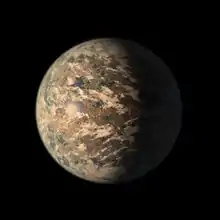 Artist's impression of TRAPPIST-1e from 2018, depicted here as a tidally locked planet with a liquid ocean. The actual appearance of the exoplanet is currently unknown, but based on its density it is likely not entirely covered in water. | |
| Discovery | |
|---|---|
| Discovered by | Spitzer Space Telescope |
| Discovery date | 22 February 2017 |
| Transit | |
| Orbital characteristics | |
| Apastron | 0.0294322±0.000017 AU |
| Periastron | 0.0291335±0.000017 AU |
| 0.02928285 (± 3.4e-07)[1] AU | |
| Eccentricity | 0.00510±0.00058[1] |
| 6.099043 (± 0.000015)[2] d | |
| Inclination | 89.860+0.10 −0.12[1] |
| Star | TRAPPIST-1[3] |
| Physical characteristics | |
Mean radius | 0.910+0.027 −0.026[1] R⊕ |
| Mass | 0.772+0.075 −0.079[1] M⊕ |
Mean density | 5.65+0.39 −0.42 g cm−3 |
| 0.930+0.063 −0.068[1] g | |
| Temperature | 246.1 ± 3.5 K (−27.05 ± 3.50 °C; −16.69 ± 6.30 °F)[2] |
It was one of seven new exoplanets discovered orbiting the star using observations from the Spitzer Space Telescope.[4] Three of the seven (e, f, and g) are in the habitable zone.[5][6] TRAPPIST-1e is similar to Earth's mass, radius, density, gravity, temperature, and stellar flux.[1][2] It is also confirmed to have a compact atmosphere like the terrestrial planets in our solar system.[7] In November 2018, researchers determined that of the seven exoplanets in the multiplanetary system, TRAPPIST-1e is the one with the greatest chance of being an Earth-like ocean planet and the one most worthy of further study with regard to habitability.[8] According to the Habitable Exoplanets Catalog, TRAPPIST-1e is one of the most potentially habitable exoplanets discovered so far.[9]
Characteristics
Mass, radius, and temperature
TRAPPIST-1e was detected with the transit method, where the planet blocked a small percentage of its host star's light when passing between it and Earth. This allowed scientists to accurately determine the planet's radius at 0.910 R⊕, with a small uncertainty of about 166–172 km. Transit-timing variations and advanced computer simulations helped constrain the planet's mass, which turned out to be 0.772 M⊕. With both the radius and mass of TRAPPIST-1e determined with low error margins, scientists could accurately calculate the planet's density, surface gravity, and composition. TRAPPIST-1e is unusual in its system as it is the only planet with a pure rock-iron composition, and the only one with a higher density than Earth (TRAPPIST-1c also appears to be entirely rock, but it has a thick atmosphere that makes it less dense than TRAPPIST-1e). It has a density of 5.65 g/cm3, about 1.024 times Earth's density of 5.51 g/cm3. The higher density of TRAPPIST-1e implies an Earth-like composition and a solid rocky surface. This is also unusual among the TRAPPIST-1 planets, as most are completely covered in either a thick steam atmosphere, a global liquid ocean, or an ice shell. TRAPPIST-1e has 93% the surface gravity of Earth, the second highest in the system. Its radius and mass are also the third least among the TRAPPIST-1 planets.[1]
The planet has a calculated equilibrium temperature of 246.1 K (−27.1 °C; −16.7 °F), given an albedo of 0.[2] For a more realistic Earth-like albedo [10] However, this provides an unrealistic picture of the surface temperature of the planet. Earth's equilibrium temperature is 255 K;[11] it is Earth's greenhouse gases that raise its surface temperatures to the levels we experience. If TRAPPIST-1e has a thick atmosphere, its surface could be much warmer than its equilibrium temperature.
Orbit
TRAPPIST-1e orbits its host star quite closely. One full revolution around TRAPPIST-1 takes only 6.099 Earth days (~146 hours) to complete. It orbits at a distance of 0.02928285 AU, or just under 3% the separation between Earth and the Sun. For comparison, the closest planet in our Solar System, Mercury, takes 88 days to orbit the Sun at a distance of 0.38 AU. Despite its close proximity to its host star, TRAPPIST-1e gets only about 60% the starlight that Earth gets from the Sun, due to the low luminosity of its star. The star would cover an angular diameter of about 2.17 degrees from the surface of the planet, and would appear about four times larger than the Sun does from Earth.
Host star
The planet orbits an (late M-type) ultracool dwarf star named TRAPPIST-1. The star has a mass of 0.089 M☉ and a radius of 0.121 R☉. It has a temperature of 2,516 K and is anywhere between 3 and 8 billion years old. In comparison, the Sun is 4.6 billion years old[12] and has a temperature of 5,778 K.[13] The star is metal-rich, with a metallicity ([Fe/H]) of 0.04, or 109% the solar amount. This is particularly odd as such low-mass stars near the boundary between brown dwarfs and hydrogen-fusing stars should be expected to have considerably less metal content than the Sun. Its luminosity (L☉) is 0.0522% of that of the Sun.
The star's apparent magnitude, or how bright it appears from Earth's perspective, is 18.8. Therefore, it is too dim to be seen with the naked eye.
Habitability
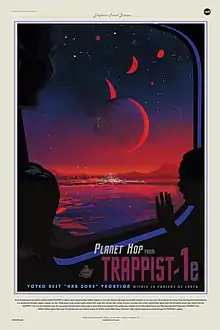
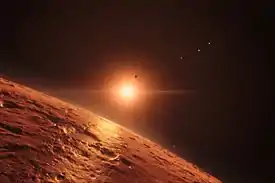
The exoplanet was announced to be orbiting within the habitable zone of its parent star, the region where, with the correct conditions and atmospheric properties, liquid water may exist on the surface of the planet. TRAPPIST-1e has a radius of around 0.91 R⊕, so it is likely a rocky planet. Its host star is a red ultracool dwarf, with only about 8% of the mass of the Sun (close to the boundary between brown dwarfs and hydrogen-fusing stars). As a result, stars like TRAPPIST-1 have the potential to remain stable for four to five trillion years, 400–500 times longer than the Sun.[14] Because of this ability to live for long periods of time, it is likely TRAPPIST-1 will be one of the last remaining stars in the Universe, when the gas needed to form new stars will be exhausted, and the existing stars begin to die off.
The planet is likely tidally locked, with one side of its hemisphere permanently facing towards the star, while the opposite side is shrouded in eternal darkness. However, between these two intense areas, there would be a sliver of habitability—called the terminator line, where the temperatures may be suitable (about 273 K [0 °C; 32 °F]) for liquid water to exist. Additionally, a much larger portion of the planet may be habitable if it supports a thick enough atmosphere to transfer heat to the side facing away from the star.
More detailed studies of TRAPPIST-1e and the other TRAPPIST-1 planets released in 2018 determined that the planet is one of the most Earth-sized worlds found, with 91% the radius, 77% the mass, 102.4% the density (5.65 g/cm3), and 93% the surface gravity. TRAPPIST-1e is confirmed to be a terrestrial planet with a solid, rocky surface. It is cool enough for liquid water to pool on the surface, but not too cold for it to freeze like on TRAPPIST-1f, g, and h.[1] The planet receives a stellar flux 0.604 times that of Earth, about a third lower than that of Earth but significantly more than that of Mars.[2] Its equilibrium temperature ranges from 225 K (−48 °C; −55 °F)[15] to 246.1 K (−27.1 °C; −16.7 °F),[2] depending on how much light the planet reflects into space. Both of these are between those of Earth and Mars as well. TRAPPIST-1e is confirmed to have a compact, hydrogen-free atmosphere like those of our Solar System's rocky planets, further raising the chances of habitability. Hydrogen is a powerful greenhouse gas, so if there was enough to be easily detected, it would mean that the surface of TRAPPIST-1e would be inhospitable.[7] Since such an atmosphere is not present, it raises the chances for the planet to have a more Earth-like atmosphere instead.
As it is one of the most promising potentially habitable exoplanets known, TRAPPIST-1e will be an early target of the James Webb Space Telescope. Planned for launch in October 2021, the telescope will allow more extensive analysis of the planet's atmosphere, facilitating the search for any chemical signs of life, or biosignatures.[16]
See also
References
- Grimm, Simon L.; Demory, Brice-Olivier; Gillon, Michael; Dorn, Caroline; Agol, Eric; Burdanov, Artem; Delrez, Laetitia; Sestovic, Marko; Triaud, Amaury H.M.J.; Turbet, Martin; Bolmont, Emeline; Caldas, Anthony; de Wit, Julien; Jehin, Emmanuel; Leconte, Jeremy; Raymond, Sean N.; Van Grootel, Valerie; Burgasser, Adam J.; Carey, Sean; Fabrycky, Daniel; Heng, Kevin; Hernandez, David M.; Ingalls, James G.; Lederer, Susan; Selsis, Franck; Queloz, Didier (5 February 2018). "The nature of the TRAPPIST-1 exoplanets". Astronomy and Astrophysics. 613: A68. arXiv:1802.01377. Bibcode:2018A&A...613A..68G. doi:10.1051/0004-6361/201732233. S2CID 3441829.
- Delrez, Laetitia; Gillon, Michael; H.M.J, Amaury; Brice-Oliver Demory, Triaud; de Wit, Julien; Ingalls, James; Agol, Eric; Bolmont, Emeline; Burdanov, Artem; Burgasser, Adam J.; Carey, Sean J.; Jehin, Emmanuel; Leconte, Jeremy; Lederer, Susan; Queloz, Didier; Selsis, Franck; Grootel, Valerie Van (9 January 2018). "Early 2017 observations of TRAPPIST-1 with Spitzer". Monthly Notices of the Royal Astronomical Society. 475 (3): 3577. arXiv:1801.02554. Bibcode:2018MNRAS.475.3577D. doi:10.1093/mnras/sty051. S2CID 54649681.
- Van Grootel, Valerie; Fernandes, Catarina S.; Gillon, Michaël; Jehin, Emmanuel; Scuflaire, Richard; et al. (5 December 2017). "Stellar parameters for TRAPPIST-1". The Astrophysical Journal. 853 (1): 30. arXiv:1712.01911. Bibcode:2018ApJ...853...30V. doi:10.3847/1538-4357/aaa023. S2CID 54034373.
- Gillon, Michaël; Triaud, Amaury H. M. J.; Demory, Brice-Olivier; Jehin, Emmanuël; Agol, Eric; Deck, Katherine M.; Lederer, Susan M.; Wit, Julien de; Burdanov, Artem (2017). "Seven temperate terrestrial planets around the nearby ultracool dwarf star TRAPPIST-1". Nature. 542 (7642): 456–460. arXiv:1703.01424. Bibcode:2017Natur.542..456G. doi:10.1038/nature21360. PMC 5330437. PMID 28230125.
- "NASA telescope reveals largest batch of Earth-size, habitable-zone planets around single star". Exoplanet Exploration: Planets Beyond our Solar System (Press release). Retrieved 22 February 2017.
- "TRAPPIST-1 Planet Lineup". NASA / Jet Propulsion Laboratory. 22 February 2017.
- De Wit, Julien; Wakeford, Hannah R.; Lewis, Nikole K.; Delrez, Laetitia; Gillon, Michaël; Selsis, Frank; Leconte, Jérémy; Demory, Brice-Olivier; Bolmont, Emeline; Bourrier, Vincent; Burgasser, Adam J.; Grimm, Simon; Jehin, Emmanuël; Lederer, Susan M.; Owen, James E.; Stamenković, Vlada; Triaud, Amaury H. M. J. (2018). "Atmospheric reconnaissance of the habitable-zone Earth-sized planets orbiting TRAPPIST-1". Nature Astronomy. 2 (3): 214–219. arXiv:1802.02250. Bibcode:2018NatAs...2..214D. doi:10.1038/s41550-017-0374-z. S2CID 119085332.
- University of Washington (21 November 2018). "Study brings new climate models of small star TRAPPIST 1's seven intriguing worlds". EurekAlert!. Retrieved 22 November 2018.
- "The Habitable Exoplanets Catalog - Planetary Habitability Laboratory @ UPR Arecibo". phl.upr.edu. Retrieved 6 February 2019.
- oe-exoplanets-catalog/calculators
- http://burro.case.edu/Academics/Astr221/SolarSys/equiltemp.html
- Fraser Cain (16 September 2008). "How Old is the Sun?". Universe Today. Retrieved 19 February 2011.
- Fraser Cain (15 September 2008). "Temperature of the Sun". Universe Today. Retrieved 19 February 2011.
- Adams, Fred C.; Laughlin, Gregory; Graves, Genevieve J. M. "Red Dwarfs and the End of the Main Sequence". Gravitational Collapse: From Massive Stars to Planets. Revista Mexicana de Astronomía y Astrofísica. pp. 46–49. Bibcode:2004RMxAC..22...46A.
- http://phl.upr.edu/projects/habitable-exoplanets-catalog/calculators
- <https://www.nasa.gov/feature/goddard/2017/icy-moons-galaxy-clusters-and-distant-worlds-among-selected-targets-for-james-webb-space
